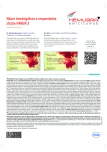Storing red cells at non-standard temperature
Authors:
P. Papoušek 1; S. Škodová 1; C. Andrýs 2; T. Suchý 3; P. Turek 4; L. Řehořová 1; R. Procházková 1,5
Authors‘ workplace:
Transfuzní oddělení, Krajská nemocnice Liberec, a. s.
1; Ústav klinické imunologie a alergologie, Fakultní nemocnice Hradec Králové
2; Oddělení kompozitních a uhlíkových materiálů, Ústav struktury a mechaniky hornin, Akademie věd České republiky, Praha
3; Transfuzní oddělení, Thomayerova nemocnice, Praha
4; Fakulta zdravotnických studií, Technická univerzita v Liberci
5
Published in:
Transfuze Hematol. dnes,26, 2020, No. 2, p. 124-130.
Category:
Original Papers
Overview
Background: Storage conditions of red cell transfusion components are set out by generally binding legal regulations. If these are not observed, the producer´s qualified person decides regarding their further use. The Society for Transfusion Medicine (STL) thus drew up Guideline No. 2015/11 defining the shortening of transfusion component usability according to the severity of non-observance. The aim of this work was to verify the impact of non-standard storage conditions on red cell transfusion components and to confirm whether the limits and their duration have been chosen appropriately.
Materials and methods: The impact of non-standard storage conditions on the quality of red cell transfusion components was verified using a temperature load test. The intensity of the load corresponded to the limits given in the STL guidelines. 40 transfusion units of Red Cells, Buffy Coat Removed in Additive Solution (BCR-AS) were included. On day 22–26, the transfusion components were exposed to the controlled temperature load – group A: 11 units, 15 °C, 6 hours, group B: 9 units, 13 °C, 6 hours and group C: 20 units, 13 °C, 48 hours. Haemolysis markers were measured on days 1, 22–26, 28, 35 and 42: free haemoglobin, K+, lactate dehydrogenase (LDH) and annexin V. In the control group (20 units of Red Cells, BCR-AS), free haemoglobin was determined on day 42.
Results: The level of free haemoglobin at the end of the storage period (day 42) did not exceed 0.8% of red cell mass in all units – on average 0.34% (A), 0.26% (B) 0.26% (C) and 0.26% in the control group. There was no statistically significant difference in the markers free haemoglobin and annexin V among the transfusion components A, B and C exposed to the temperature load. Groups B and C did not differ in the level of free haemoglobin, K+, LDH and annexin V. The level of K+ was statistically higher in group A compared to groups B and C.
Conclusion: The temperature limits given by STL are safe. The temperature load of 13 °C and 15 °C during storage only mildly affects quality and haemolysis after a temperature load was within safe limits. The degree of haemolysis measured using free haemoglobin did not differ among the groups. The level of K+ was influenced more by the temperature of the load than by its duration.
Keywords:
red cells – temperature – haemolysis – storage
Sources
1. Vyhláška č. 143/2008 Sb., o stanovení bližších požadavků pro zajištění jakosti a bezpečnosti lidské krve a jejích složek (vyhláška o lidské krvi), ve znění pozdějších předpisů.
2. Procházková R. Markery poškození krevních buněk. Transfuze Hematol Dnes. 2013;19 : 240–243.
3. Hess JR. Measures of stored red blood cell quality. Vox Sang. 2014;107 : 1–9.
4. Putter JS, Seghatchian J. Cumulative erythrocyte damage in blood storage and relevance to massive transfusions: selective insights into serial morphological and biochemical findings. Blood Transfus. 2017;15 : 348–356.
5. Seghatchian J, Krailadsiri P. Red cell storage lesion assesed by the levels of potassium, hemoglobin and annexin V in supernatantant. Transfus Apher Sci. 2002;26 : 121–127.
6. Sparrow RL, Healey G, Patton KA, et al. Red blood cell age determines the impact of storage and leukocyte burden on cell adhesion molecules, glycophorin A and the release of annexin V. Transfus Apher Sci. 2006;34 : 15–23.
7. Guide to the preparation, use and quality assurance of blood components. 19th ed. Strasbourg: Council of Europe, 2017; 302.
8. Doporučení Společnosti pro transfuzní lékařství ČLS JEP č. STL2015_11 ze dne 2. 11. 2015 verze 1 [on-line]. Dostupné na: https://www.transfuznispolecnost.cz/doporucene-postupy/skladovani-a-preprava-krve-krevnich-slozek-suroviny-pro-dalsi-vyrobu-transfuznich-pripravku-231. Staženo: 17. 2. 2020.
9. Hancock V, Beard M, Naik F, et al. Effects of deviations in the recommended storage temperatures of RBCs on their invitro quality. Transfus Med. 2009;19(s1)(21):PO4.
10. Wagner T, Pabst MA, Leitinger G, et al. Impact of constant storage temperatures and multiple warming cycles on the quality of stored red blood cells. Vox Sang. 2014;106 : 45–54.
11. Gulliksson H, Nordahl-Källman AS. Effect of transient warming of red blood cells for up to 24 h: in vitro characteristics in CPD/saline-adenine-glucose-mannitol environment. Vox Sang. 2014;106 : 61–67.
12. Ecker T, Hitzler WE. Effect of 6-hour exposure to 20 degrees C on the ATP content and other biochemical measures of CPDA-1 packed red cells. Clin Lab. 2000;46 : 291–293.
13. Procházková R. Multikomponentní aferetické odběry krve. 1. vyd. Brno: Tribun EU, 2009; 51.
Labels
Haematology Internal medicine Clinical oncologyArticle was published in
Transfusion and Haematology Today

2020 Issue 2
Most read in this issue
- Castleman disease, one of the causes of chronic systemic inflammatory response as well as fluid retention, vasculitis and immune disorders sometimes – international criteria, 2017
- Thrombotic microangiopathies
- Surprising findings in the bone marrow: what lies behind it?
- Treatment of Langerhans cell histiocytosis in adults
